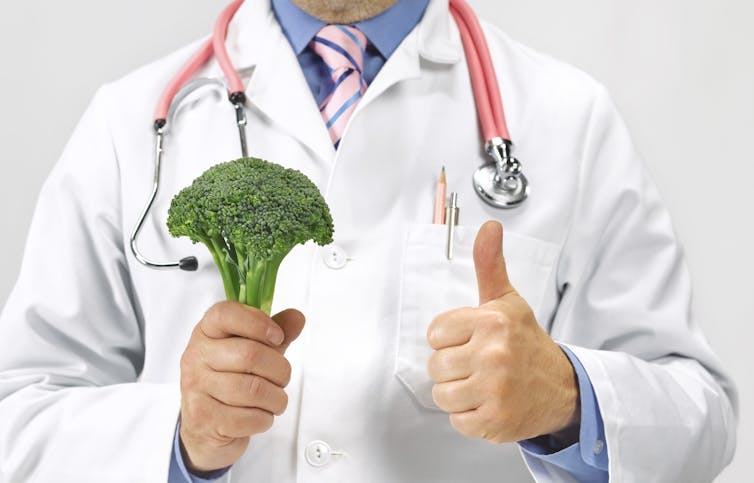
Peter Dazeley/The Image Bank via Getty Images
Nathaniel Johnson, University of North Dakota and Madeline Comeau, University of North Dakota
On television shows like “Grey’s Anatomy,” “The Resident” and “Chicago Med,” physicians seem to always have the right answer.
But when it comes to nutrition and dietary advice, that may not be the case.
One of us is an assistant professor of nutrition and dietetics; the other is a medical student with a master’s degree in nutrition.
Both of us understand the powerful effects that food has on your health and longevity. A poor diet may lead to cardiovascular disease, diabetes, obesity and even psychological conditions like depression and anxiety. Diet-related diseases are the leading causes of death in the U.S., and a poor diet is responsible for more deaths than smoking.
These health problems are not only common and debilitating, but expensive. Treating high blood pressure, diabetes and high cholesterol costs about US$400 billion per year. Within 25 years, those costs are expected to triple, to $1.3 trillion.
These facts support the need for physicians to give accurate advice about diet to help prevent these diseases. But how much does a typical physician know about nutrition?
What doctors don’t know
In a 2023 survey of more than 1,000 U.S. medical students, about 58% of respondents said they received no formal nutrition education while in medical school for four years. Those who did averaged about three hours of nutrition education per year.
That is woefully short of the goals set by the U.S. Committee on Nutrition in Medical Education back in 1985: that med students should receive a total of 25 hours of nutrition education while in school – a little more than six hours per year.
But a 2015 study showed only 29% of medical schools met this goal, and a 2023 study suggests the problem has become even worse – only 7.8% of med students reported 20 or more hours of nutrition education across all four years of med school. If this is representative of medical schools throughout the country, it has happened despite efforts to bolster nutrition education through numerous government initiatives.
Not surprisingly, the lack of education has had a direct impact on physicians’ nutrition knowledge. In a study of 257 first- and second-year osteopathic medical students taking a nutrition knowledge quiz, more than half flunked the test. Prior to the test, more than half the students – 55% – felt comfortable counseling patients on nutrition.
Unfortunately, this problem is not limited to U.S. medical schools. A 2018 global study concluded that no matter the country, nutrition education of med students is insufficient throughout the world.
Bringing nutrition education back
Even though evidence suggests that nutrition education can be effective, there are many reasons why it’s lacking. Medical students and physicians are some of the busiest people in society. The amount of information taught in medical curricula is often described as overwhelming – like drinking out of a fire hose.
First- and second-year medical students focus on dense topics, including biochemistry, molecular biology and genetics, while they learn clinical skills such as interviewing patients and understanding heart and lung sounds. Third- and fourth-year students are practicing in clinics and hospitals as they learn from physicians and patients.
As a result, their schedules are already jammed. There is no room for nutrition. And once they are physicians, it gets no better. Providing preventive care including nutrition counseling to patients would take them more than seven hours per week – and that’s not counting the time they would have to spend on continuing education to keep up with new findings in nutrition science.
On top of that, the lack of nutrition education in medical schools has been attributed to a dearth of qualified instructors for nutrition courses, as most physicians do not understand nutrition well enough to teach it.
Ironically, many medical schools are part of universities that have nutrition departments with Ph.D.-trained professors; those academicians could fill this gap by teaching nutrition to medical students. But those classes are often taught by physicians who may not have adequate nutrition training – which means truly qualified instructors, within reach of most medical schools, are left out of the process.
Finding the right advice
The best source of nutrition information, whether for medical students or the general public, is a registered dietitian, certified nutrition specialist or some other type of nutrition professional with multiple degrees and certification. They study for years and record many practice hours in order to give dietary advice.
Although anyone can make an appointment with a nutrition professional for dietary counseling, typically a referral from a health care provider like a physician is needed for the appointment to be covered by insurance. So seeing a physician or other primary care provider is often a step before meeting with a nutrition professional.
This extra step might be one reason why many people look elsewhere, such as on their phones, for nutrition advice. However, the worst place to look for accurate nutrition information is social media. There, about 94% of posts about nutrition and diet are of low value – either inaccurate or lacking adequate data to back up the claim.
Keep in mind that anyone can post nutrition advice on social media, regardless of their qualifications. Good dietary advice is individualized and takes into account one’s age, sex, goals, body weight, goals and personal preferences. This complexity is tough to capture in a brief social media post.
The good news is that nutrition education, when it occurs, is effective, and most medical students and physicians acknowledge the critical role nutrition plays in health. In fact, close to 90% of med students say nutrition education should be a mandatory part of medical school.
We hope that nutrition education, after being devalued or ignored for decades, will soon be an integral part of every medical school’s curriculum. But given its history and current status, this seems unlikely to happen anytime soon.
In the meantime, those who want to learn more about a healthy diet should meet with a nutrition professional, or at the very least read the 2020-2025 Dietary Guidelines for Americans or the World Health Organization’s healthy diet recommendations.
Nathaniel Johnson, Assistant Professor of Nutrition and Dietetics, University of North Dakota and Madeline Comeau, Medical Student, University of North Dakota
This article is republished from The Conversation under a Creative Commons license. Read the original article.






























































